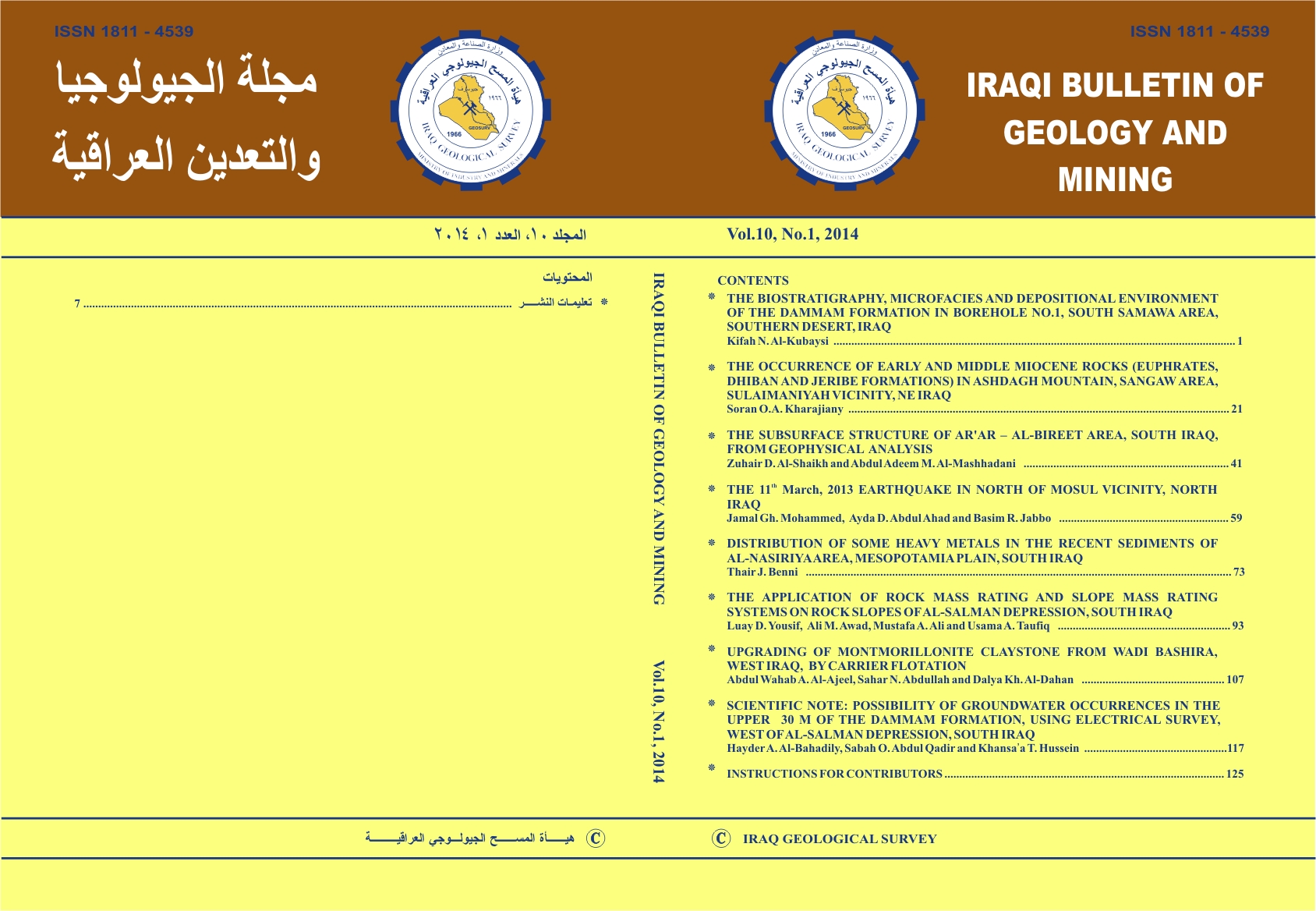Abstract
This study deals with the biostratigraphy, microfacies and depositional environments of the rocks of the Dammam Formation (Eocene) encountered in Borehole No.1 in South Samawa, Southern Desert, Iraq. Seventy four samples were studied and three formations were identified, they are from the oldest to the youngest: Rus Formation (Early Eocene), Dammam Formation (Middle – Late Eocene) and Euphrates Formation (Early Miocene). Different species of the foraminifera were identified within the Dammam Formation, two biozones were recognized; they are from the older to the younger:
- Nummulites gizehensis Zone of Middle Eocene (Late Lutetian) age
- Miliolids – Peneroplid Assemblage Zone of Late Eocene (Bartonian) age
The first biozone indicates Middle Eocene age for the Middle Member of the Dammam Formation and the second biozone indicates Late Eocene age for the Upper Member of the formation.
The Dammam Formation revealed three microfacies depending on the fossils content and lithological characters, these are from top to bottom:
- Dolomitic Wackestone – Packstone Facies
- Foraminiferal Dolomitic Packstone Facies
- Nummulitic Dolomitic Packstone – Floatstone Facies
The depositional environment of the Dammam Formation was determined by application of the environment triangle depending on the species of different groups of foraminiferal assemblages, which show that the depositional environment of the Dammam Formation extends from shelf sands area (winnowed edge sands FZ6) and the shoal to the open platform area (shelf lagoon open circulation FZ7) and its continuation to the restricted platform area (restricted circulation inner shelf and tidal flats FZ8).
- Nummulites gizehensis Zone of Middle Eocene (Late Lutetian) age
- Miliolids – Peneroplid Assemblage Zone of Late Eocene (Bartonian) age
The first biozone indicates Middle Eocene age for the Middle Member of the Dammam Formation and the second biozone indicates Late Eocene age for the Upper Member of the formation.
The Dammam Formation revealed three microfacies depending on the fossils content and lithological characters, these are from top to bottom:
- Dolomitic Wackestone – Packstone Facies
- Foraminiferal Dolomitic Packstone Facies
- Nummulitic Dolomitic Packstone – Floatstone Facies
The depositional environment of the Dammam Formation was determined by application of the environment triangle depending on the species of different groups of foraminiferal assemblages, which show that the depositional environment of the Dammam Formation extends from shelf sands area (winnowed edge sands FZ6) and the shoal to the open platform area (shelf lagoon open circulation FZ7) and its continuation to the restricted platform area (restricted circulation inner shelf and tidal flats FZ8).
Keywords
Dammam Formation
Eocene
Iraq
Microfacies
Nummulites
Abstract
تمت دراسة الطباقية الحياتية لتكوين الدمام (عمر الإيوسين) في بئر رقم 1، جنوب السماوة، الصحراء الجنوبية في العراق. وذلك من خلال دراسة 74 نموذج ووجد أن العمود الطباقي في البئر يتمثل بثلاث تكوينات هي من الأقدم الى الأحدث: تكوين الرص (الإيوسين المبكر)، تكوين الدمام (الإيوسين الأوسط –المتأخر) وتكوين الفرات (المايوسين المبكر). تم تمييز أنواع مختلفة من الفورامنيفيرا ضمن تكوين الدمام وتم تمييز نطاقين حياتيين وهما:
- Nummulites gizehensis Zone of Middle Eocene age (Late Lutetian) age
- Miliolids ̶ Peneroplid Assemblage Zone of Late Eocene age (Bartonian) age
حدد النطاق الأول عمر الإيوسين الأوسط للعضو الأوسط لتكوين الدمام، بينما حدد النطاق الثاني عمر الإيوسين المتأخر للعضو الأعلى للتكوين.
أظهرت الدراسة ثلاث سحنات دقيقة لتكوين الدمام اعتماداً على التغير الحاصل في الوصف الصخاري والحياتي، وهي من الأعلى الى الأسفل:
- سحنة الحجر الجيري الدولومايتي الواكي – المرصوص
- سحنة الحجر الجيري الدولومايتي المرصوص الحامل للفورامينيفيرا
- سحنة الحجر الجيري الدولومايتي النيميولايتي المرصوص – الفلوتستون
تم استنباط البيئة الترسيبية للصخور الجيرية لتكوين الدمام وذلك بتطبيق مثلث البيئة باستخدام أفراد مجاميع الفورامنيفيرا المختلفة بصورة أساسية، حيث تبين أن منطقة ترسيب التكوين تمتد من منطقة رمال الرصيف، حيث يتكون جسم الحيد من الفورامينيفيرا الكبيرة (النيميولايت) الى منطقة الرصيف القاري المفتوح وعلى امتداده وصولاً الى منطقة المياه المحصورة.
- Nummulites gizehensis Zone of Middle Eocene age (Late Lutetian) age
- Miliolids ̶ Peneroplid Assemblage Zone of Late Eocene age (Bartonian) age
حدد النطاق الأول عمر الإيوسين الأوسط للعضو الأوسط لتكوين الدمام، بينما حدد النطاق الثاني عمر الإيوسين المتأخر للعضو الأعلى للتكوين.
أظهرت الدراسة ثلاث سحنات دقيقة لتكوين الدمام اعتماداً على التغير الحاصل في الوصف الصخاري والحياتي، وهي من الأعلى الى الأسفل:
- سحنة الحجر الجيري الدولومايتي الواكي – المرصوص
- سحنة الحجر الجيري الدولومايتي المرصوص الحامل للفورامينيفيرا
- سحنة الحجر الجيري الدولومايتي النيميولايتي المرصوص – الفلوتستون
تم استنباط البيئة الترسيبية للصخور الجيرية لتكوين الدمام وذلك بتطبيق مثلث البيئة باستخدام أفراد مجاميع الفورامنيفيرا المختلفة بصورة أساسية، حيث تبين أن منطقة ترسيب التكوين تمتد من منطقة رمال الرصيف، حيث يتكون جسم الحيد من الفورامينيفيرا الكبيرة (النيميولايت) الى منطقة الرصيف القاري المفتوح وعلى امتداده وصولاً الى منطقة المياه المحصورة.
